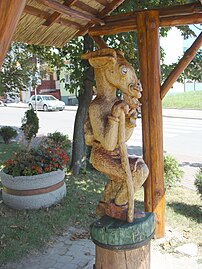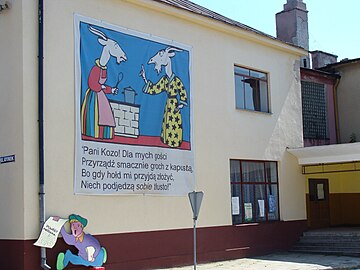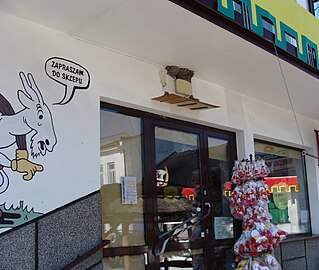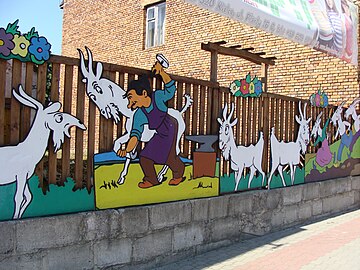Pacanów
Pacanów | ||
|---|---|---|
Town | ||
 | ||
|
Car plates TBU | | |
| Website | pacanow | |
Pacanów [paˈt͡sanuf], sometimes referred to as the European Capital of Fable, is a town in Busko County, Świętokrzyskie Voivodeship in south-central Poland. It is the seat of Gmina Pacanów. It had a population of 1137 in 2003. In modern times the village is partly noted for its connection to the fictional character Koziołek Matołek. It lies in historic Lesser Poland, approximately 25 kilometres (16 mi) east of Busko-Zdrój and 62 km (39 mi) south-east of the regional capital Kielce.
History
Pacanów was first mentioned in a document from 1110 – 1117, issued by the Bishop of Kraków Maur, in which the erection of St. Martin's church was confirmed. At that time, the village probably belonged to a man named Siemian, who is mentioned in the document. The existence of the parish church was confirmed on August 1219 by the incumbent Bishop of Kraków Iwo Odrowąż, and in 1265, the village was granted Magdeburg rights by Prince Bolesław V the Chaste. In the same period, a number of local villages were also granted town charters (Połaniec, Nowy Korczyn, Koprzywnica and Opatowiec). The original charter of Pacanów has not been preserved, but in a document issued on February 26, 1603, King Sigismund III Vasa reconfirmed its town status.
Pacanów remained a private
As a result of the Partitions of Poland, having been for centuries in the Sandomierz Voivodeship, Pacanów became part of the Austrian Habsburg Empire. Between 1815 and 1915, it belonged to Russian-controlled Congress Poland. On August 24, 1813, the town was completely flooded by the Vistula River. In 1820, Pacanów had circa 1,000 residents, half of whom were Jewish. In 1869, following the failed January Uprising, the Imperial Russian authorities revoked the town status and reduced it to a village.
In 1918, with Poland regaining independence, Pacanów became part of the
Personalities associated with the town
- Feliks Paweł Jarocki 19th century zoologist
- Kornel Makuszyński and Marian Walentynowicz, creators of
- Koziołek Matołek mythical goat-hero associated with Pacanów
Koziołek Matołek
The fictional character Koziołek Matołek, or Matołek the Billy-Goat in English, was from Pacanów and it was where his adventures were set. He was created by Kornel Makuszyński (story) and Marian Walentynowicz (art) in one of the first and most famous Polish comics back in 1933.
Once when Makuszyński and Walentynowicz were sitting in a coffee house in Kraków, they spotted a sad looking man sipping a drink at a nearby table. They asked him why he looked so gloomy, and he told them that he came from the small town of Pacanów and was wondering how to help the town prosper. Makuszyński and Walentynowicz decided then to help him by popularizing the small town in their books.
It became a
To this day Koziołek Matołek remains Pacanów's claim to fame, and images of him can be seen all around the village.
-
Koziołek Matołek monument in Pacanów square
-
Floral monument
-
Wooden monument
-
Koziołek Matołek on a post box
-
Restaurants, shops, offices, all feature Koziołek Matołek
-
Koziołek Matołek is inviting customers into a shop
-
Koziołek Matołek on a road-side fence
There exists a Fairy Tale Center in the town.[3]
References
- ^ "Pacanow, Poland".
- ISBN 978-0-253-35599-7.
- ^ "Centrum Bajki w Pacanowie | kultura, atrakcje, warsztaty, kino, zabawy, animacje dla dzieci, wakacje". 21 October 2016. Retrieved 13 June 2023.







